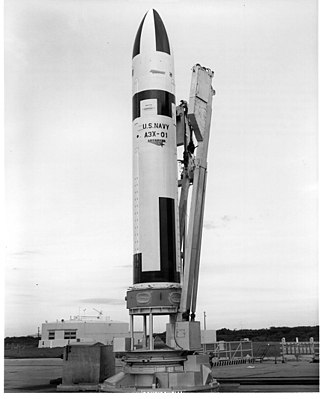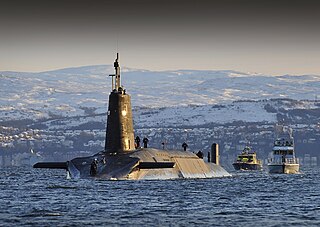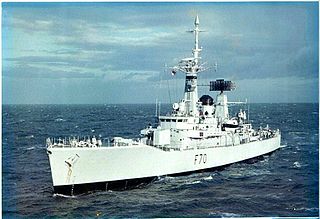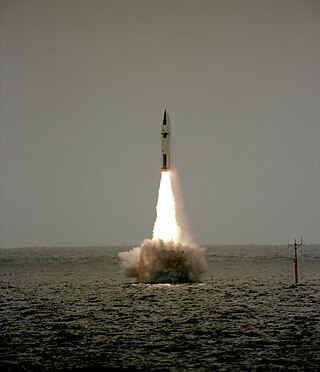
The UGM-27 Polaris missile was a two-stage solid-fueled nuclear-armed submarine-launched ballistic missile (SLBM). As the United States Navy's first SLBM, it served from 1961 to 1980.

The Polaris Sales Agreement was a treaty between the United States and the United Kingdom which began the UK Polaris programme. The agreement was signed on 6 April 1963. It formally arranged the terms and conditions under which the Polaris missile system was provided to the United Kingdom.

The Douglas GAM-87 Skybolt was a hypersonic air-launched ballistic missile (ALBM) developed by the United States during the late 1950s. The basic concept was to allow US strategic bombers to launch their weapons from well outside the range of Soviet defenses, as much as 1,000 miles (1,600 km) from their targets. To do this in an air-launched form, a lightweight thermonuclear warhead was needed. Initially, the W47 from the Polaris missile was selected, but it was later replaced by the W59 from the Minuteman missile.

The Vanguard class is a class of nuclear-powered ballistic missile submarines (SSBNs) in service with the Royal Navy. The class was introduced in 1994 as part of the Trident nuclear programme, and comprises four vessels: Vanguard, Victorious, Vigilant and Vengeance, built between 1986 and 1999 at Barrow-in-Furness by Vickers Shipbuilding and Engineering, now owned by BAE Systems. All four boats are based at HM Naval Base Clyde , 40 km (25 mi) west of Glasgow, Scotland.

Chevaline was a system to improve the penetrability of the warheads used by the British Polaris nuclear weapons system. Devised as an answer to the improved Soviet anti-ballistic missile defences around Moscow, the system increased the probability that at least one warhead would penetrate Moscow's anti-ballistic missile (ABM) defences, something which the Royal Navy's earlier UGM-27 Polaris re-entry vehicles (RVs) were thought to be unlikely to do.
A ballistic missile submarine is a submarine capable of deploying submarine-launched ballistic missiles (SLBMs) with nuclear warheads. These submarines became a major weapon system in the Cold War because of their nuclear deterrence capability. They can fire missiles thousands of kilometers from their targets, and acoustic quieting makes them difficult to detect, thus making them a survivable deterrent in the event of a first strike and a key element of the mutual assured destruction policy of nuclear deterrence. The deployment of ballistic missile submarines is dominated by the United States and Russia. Smaller numbers are in service with France, the United Kingdom, China and India; North Korea is also suspected to have an experimental submarine that is diesel-electric powered.

The George Washington class was a class of nuclear-powered ballistic missile submarines deployed by the United States Navy. George Washington, along with the later Ethan Allen, Lafayette, James Madison, and Benjamin Franklin classes, comprised the "41 for Freedom" group of submarines that represented the Navy's main contribution to the nuclear deterrent force through the late 1980s.

41 for Freedom refers to the US Navy Fleet Ballistic Missile (FBM) submarines from the George Washington, Ethan Allen, Lafayette, James Madison, and Benjamin Franklin classes. All of these submarines were commissioned 1959–1967, as the goal was to create a credible, survivable sea-based deterrent as quickly as possible. These submarines were nicknamed "41 for Freedom" once the goal of 41 nuclear-powered ballistic missile submarines (SSBNs) was established in the early 1960s. The 1972 SALT I Treaty limited the number of American submarine-launched ballistic missile tubes to 656, based on the total missile tubes of the forty-one submarines, in line with the treaty's goal of limiting strategic nuclear weapons to the number already existing.

HMS Resolution (S22) was the first of the Royal Navy's Resolution-class ballistic missile submarines. She operated from 1968 until 1994 providing the UK Polaris at sea nuclear deterrent.

The County class was a class of British guided missile destroyers, the first such warships built by the Royal Navy. Designed specifically around the Seaslug anti-aircraft missile system, the primary role of these ships was area air defence around the aircraft carrier task force in the nuclear-war environment.

The Leander-class, or Type 12I (Improved) frigates, comprising twenty-six vessels, was among the most numerous and long-lived classes of frigate in the Royal Navy's modern history. The class was built in three batches between 1959 and 1973. It had an unusually high public profile, due to the popular BBC television drama series Warship. The Leander silhouette became synonymous with the Royal Navy through the 1960s until the 1980s.

The Valiant class were a class of nuclear-powered fleet submarines in service with the Royal Navy from the mid-1960s until 1994. They were the first fully British nuclear fleet submarine; the earlier HMS Dreadnought used an American nuclear reactor. There were only two boats in the class, the first, Valiant commissioned in 1966 three years after Dreadnought, and Warspite the following year. Both were built by Vickers at Barrow-in-Furness.

The Nassau Agreement, concluded on 21 December 1962, was an agreement negotiated between President of the United States, John F. Kennedy, and Harold Macmillan, the Prime Minister of the United Kingdom, to end the Skybolt Crisis. A series of meetings between the two leaders over three days in the Bahamas followed Kennedy's announcement of his intention to cancel the Skybolt air-launched ballistic missile project. The US agreed to supply the UK with Polaris submarine-launched ballistic missiles for the UK Polaris programme.

His Majesty's Naval Base, Clyde, primarily sited at Faslane on the Gare Loch, is one of three operating bases in the United Kingdom for the Royal Navy. It is the navy's headquarters in Scotland and is best known as the home of Britain's nuclear weapons, in the form of nuclear submarines armed with Trident missiles.

HMS Renown (S26) was the third of the Royal Navy's Resolution-class ballistic missile submarines.

HMS Revenge (S27) was the fourth of the Royal Navy's Resolution-class ballistic missile submarines.

The Royal Navy Submarine Service is one of the five fighting arms of the Royal Navy. It is sometimes known as the Silent Service, as submarines are generally required to operate undetected.

The Dreadnought class is the future replacement for the Vanguard class of ballistic missile submarines. Like their predecessors they will carry Trident II D-5 missiles. The Vanguard submarines entered service in the United Kingdom in the 1990s with an intended service life of 25 years. Their replacement is necessary if the Royal Navy is to maintain a continuous at-sea deterrent (CASD), the principle of operation behind the Trident system.

Trident, also known as the Trident nuclear programme or Trident nuclear deterrent, covers the development, procurement and operation of nuclear weapons in the United Kingdom and their means of delivery. Its purpose as stated by the Ministry of Defence is to "deter the most extreme threats to our national security and way of life, which cannot be done by other means". Trident is an operational system of four Vanguard-class submarines armed with Trident II D-5 ballistic missiles, able to deliver thermonuclear warheads from multiple independently targetable re-entry vehicles (MIRVs). It is operated by the Royal Navy and based at Clyde Naval Base on the west coast of Scotland. At least one submarine is always on patrol to provide a continuous at-sea capability. The missiles are manufactured in the United States, while the warheads are British.

The United Kingdom's Polaris programme, officially named the British Naval Ballistic Missile System, provided its first submarine-based nuclear weapons system. Polaris was in service from 1968 to 1996.






















